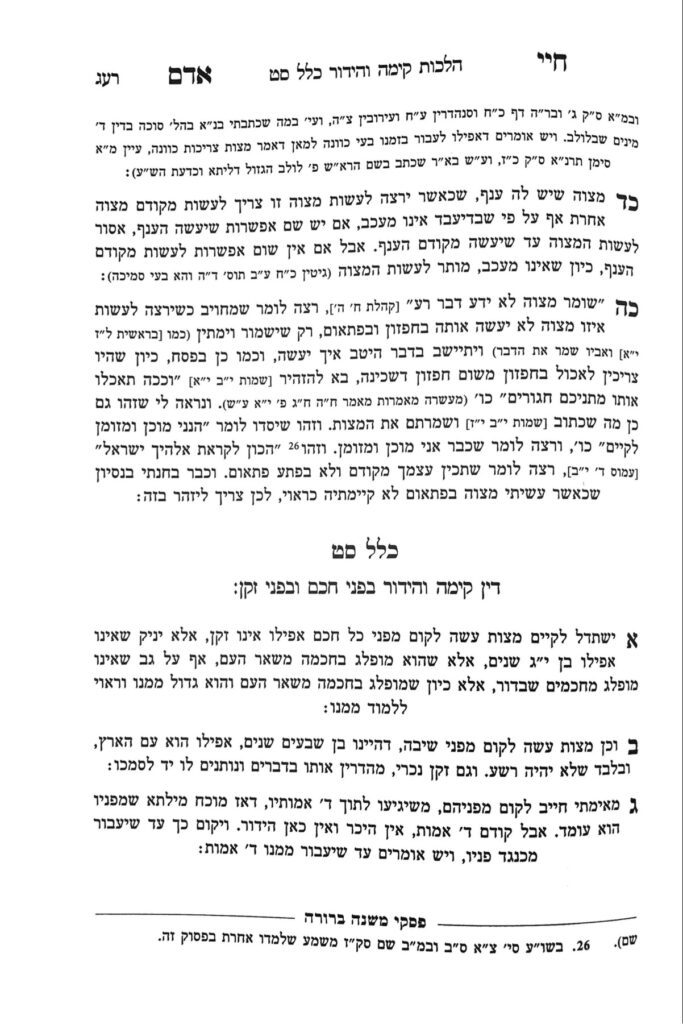We have finished Klal 68. The Sefer Nasiach Bechukecha, which is a peirush on our Klal, adds some other concepts not discussed by the Chayei Adam. We learned about five concepts yesterday. The final concept he points out is the concept of af al pi sheyatza, motzi, that one is able to help others fulfill their mitzvah obligation even though they have already been yotzei themselves.
We have learned about the concept of shomeah k’oneh, that someone can listen to another person fulfilling a mitzvah and be yotzei through them. We apply this concept to many mitzvos, including shofar, kiddush and megillah. One of the conditions for shomeah k’oneh to work is that the one being motzi must be saying words of a mitzvah. For example, when one recites kiddush for another, they are being motzi the other through the words of kiddush they are reciting. If the motzi has no chiyuv in kiddush, such as a child (who is only chayav out of chinuch), one cannot be yotzei with them, because the words that are being recited are not words of a mitzvah.
In a scenario where one person is making kiddush for multiple people, such as Reuvain making kiddush to be motzi his wife and a guest, they are all yotzei with that kiddush. If Reuvain was already yotzei kiddush, and Shimon is unable to recite kiddush on his own, is Reuvain able to recite kiddush again in order to be motzi Shimon? Reuvain was already yotzei kiddush, so arguably it is not a mitzvah for him to recite kiddush, and he should not be able to be motzi Shimon?
Thus, we enter into the concept of arvus, that all of Klal Yisroel is responsible for one another. Even though Reuvain was already yotzei kiddush, he has some level of chiyuv to facilitate Shimon’s chiyuv. The Gemara says that we can use this chiyuv of arvus to place enough of a chiyuv on Reuvain that when he recites kiddush again, it has some element of mitzvah to it, such that he can be motzi Shimon with a kiddush of mitzvah. This concept is known as af al pi sheyatza, motzi.
The mechanics of af al pi sheyatza, motzi are based on the concept known as arvus. The Rosh writes that women do not have arvus. He explains that arvus came from the bris that Klal Yisroel made on Har Gerizim and Har Eival, in which Klal Yisroel made a covenant that they would be responsible for each other. According to the Rosh, this bris was made in the context of the men only. Thus, according to the Rosh, if Reuvain was already yotzei kiddush, seemingly, he would not be able to be motzi his wife.
However, Rav Akiva Eiger writes that this thought process is a mistake. The Rosh only meant that women did not accept the responsibility of arvus on mitzvos in which they are not chayav. However, they certainly accepted arvus for mitzvos in which they are chayav. Thus, Reuvain can be motzi his wife in kiddush and vice versa, as women are chayav in kiddush. On the other hand, they cannot be motzi other in mitzvos in which they are not chayav, and vice versa.
The Gemara has a discussion regarding the ability for a man to be motzi a woman in birchas hamazon. Some hold that the chiyuv of birchas hamazon is connected to being given a portion in Eretz Yisroel. Those that hold that it is connected to Eretz Yisroel hold that men are therefore chayav in birchas hamazon deoraysa, but women are only chayav derabanan. If so, a man would not be able to be motzi his wife in birchas hamazon, and vice versa. That is what the Rosh was referring to..
Although this is not our primary discussion, we see the extent to which arvus applies, and how it applies to the concept of af al pi sheyatza, motzi.
Summary
Af al pi sheyatza, motzi, is the concept that one can be motzi another in a mitzvah obligation even though they were already yotzei themselves.



